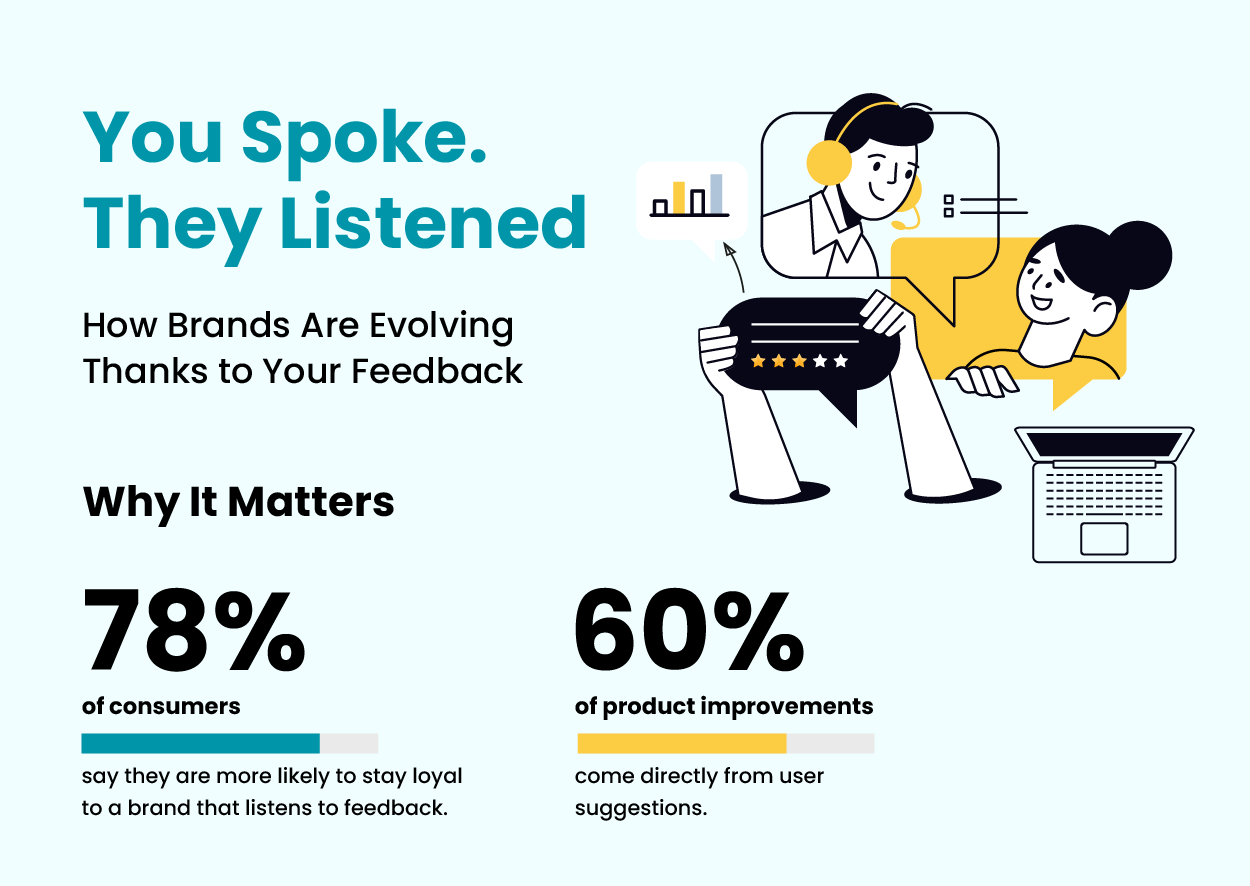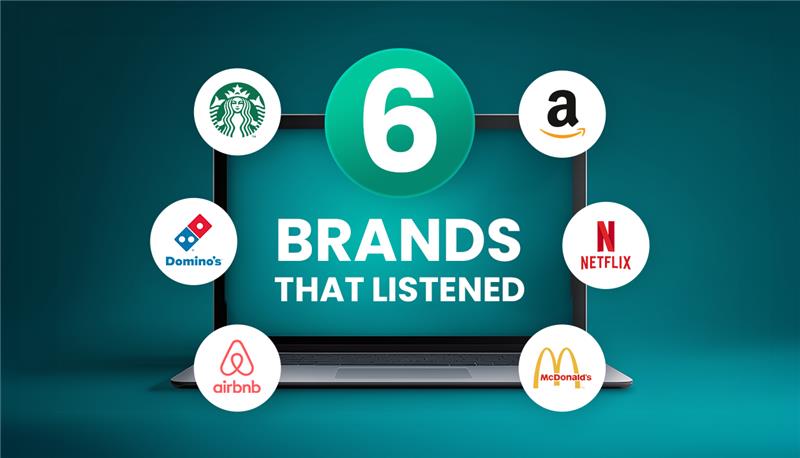Today your voice as a consumer carries more weight than you might imagine. That casual comment, that honest review, that moment of frustration you shared online – it’s all being heard, analyzed, and surprisingly often, acted upon. The most successful brands today aren’t just selling to you; they’re actually listening to you, learning from you, and sometimes completely transforming because of you.
This is the age where consumers aren’t just buyers – they are co-creators, influencers of innovation, and also the reason behind some of the most remarkable business transformations.

Let’s explore six incredible customer feedback success stories that prove your voice doesn’t just matter – it literally reshapes the brands you love.
1. Starbucks: The Coffee Revolution Started with You
Around 2008, coffee lovers everywhere were vocal about their disappointment. The cozy neighborhood coffee shop vibe was disappearing, replaced by what felt like fast-food efficiency. Customers weren’t just unhappy – they were heartbroken.
But here’s where Starbucks did something magical. Instead of dismissing the criticism, they created a digital suggestion box called “My Starbucks Idea” and invited everyone to share their thoughts. What happened next was extraordinary. Coffee enthusiasts from around the world started pouring in suggestions, from the practical (“Can we get better Wi-Fi?”) to the revolutionary (“What about a consistent coffee blend that tastes the same everywhere?”).
The transformation was remarkable. That consistent coffee blend customers were asking for? It became Pike Place Roast, now one of their most popular offerings. Those busy professionals who wished they could skip the line? Their suggestions led to mobile ordering, which completely changed how we buy coffee. Even the beloved seasonal drinks and customizable Frappuccinos were born from customer ideas.
Perhaps the most beautiful part of this story is how Starbucks didn’t just implement these changes quietly. They celebrated the customers whose ideas made it to reality, creating a community where everyone felt heard. It was no longer just about buying coffee; it was about being part of the Starbucks story.
Today, when platforms like Panel Station make it easier than ever for consumers to directly collaborate with brands, this kind of transformation is becoming the norm rather than the exception. Your ideas don’t just influence what you buy – they shape what gets created.
2. Domino’s Pizza: The Honesty That Changed Everything
By 2009, Domino’s had become the punchline of pizza jokes. Social media was ruthless – customers weren’t just complaining about the taste, they were making memes about it. The customer feedback was devastating: “tastes like cardboard,” “worst pizza ever,” and much worse.
Most companies would have tried to spin their way out of this disaster. Domino’s did the opposite. They took every piece of harsh criticism seriously and decided to completely reinvent their pizza from scratch. But they didn’t stop there – they made their customers part of the solution.
The company’s leadership spent months reading through thousands of customer reviews, understanding exactly what people hated and what they were craving instead. They brought in pizza lovers to taste-test new recipes, incorporated suggestions about crust texture, sauce flavors, and cheese quality. It wasn’t just product development; it was collaborative creation with their most disappointed customers.
When they relaunched, Domino’s did something unprecedented. They featured real customer complaints in their advertising, owning up to their mistakes and showcasing how they’d listened and changed. They even invited some of their harshest critics to try the new pizza and share their honest reactions.
The transformation was so complete that people who had sworn off Domino’s were not only coming back but becoming brand advocates. The company that was once the subject of pizza jokes became a case study in how authentic listening and genuine change can resurrect a brand. More importantly, they proved that customer feedback, even when it stings, can be the most valuable gift a business receives.

3. Netflix: When Viewers Became the Programming Directors
In the early days of streaming, customers were clear about their frustrations: they wanted to watch what they wanted, when they wanted, without waiting for weekly episodes or worrying about time slots.
But Netflix took customer feedback to an entirely new level. They didn’t just listen to what people said – they watched what people did. Netflix noticed that viewers would binge-watch entire seasons of shows when given the chance. They saw that people loved political dramas, were fascinated by Kevin Spacey’s performances, and appreciated David Fincher’s directing style. Instead of ignoring these patterns, they connected the dots.
This led to one of the most revolutionary decisions in entertainment history: creating original content based directly on viewer preferences. “House of Cards” wasn’t just a show; it was a carefully crafted response to exactly what Netflix customers had been telling them they wanted through their viewing habits.
4. Airbnb: Building Trust Through Transparency
When Airbnb first launched, the concept of staying in a stranger’s home seemed crazy to most people. The early customer feedback was filled with concerns: “How do I know this place is clean?” “What if the host is weird?” “What if something goes wrong?” These weren’t just casual complaints – they were fundamental barriers to the entire business model.
The brilliant part of Airbnb’s response was recognizing that their customers weren’t just pointing out problems; they were designing the solution. Every concern about trust led to a feature that built more trust.
But Airbnb went deeper than just addressing complaints. They understood that their customers wanted to be part of a community, not just a transaction. The review system became more than quality control – it became storytelling. Guests didn’t just rate their stays; they shared experiences, offered tips to future visitors, and helped hosts improve their offerings.
Today, when you book an Airbnb, you’re not just choosing accommodation – you’re participating in a continuous feedback loop that makes every stay better for everyone who comes after you.
5. Amazon: The Empire Built on Listening
Amazon’s story is perhaps the ultimate example of building an empire by obsessing over customer feedback. From the very beginning, Jeff Bezos made it clear that customer satisfaction wasn’t just important – it was the only thing that mattered. But what made Amazon different was how systematically they turned customer complaints into innovations.
In the early days, customers complained about slow shipping. Amazon’s response wasn’t just to ship faster – they created Prime membership, fundamentally changing customer expectations about delivery speed. When people found it frustrating to navigate through multiple pages to make a purchase, Amazon invented one-click buying, making online shopping as simple as pressing a single button.
The customer review system at Amazon wasn’t just about helping people make buying decisions – it became a massive feedback mechanism that influenced everything from product development to inventory decisions. Your browsing history, purchase patterns, review activity, and even customer service calls all feed into systems designed to make your next experience better.
6. McDonald’s Biggest Menu Revolution Started with Customer Complaints
McDonald’s all-day breakfast menu is perhaps one of the most requested menu changes in fast-food history, and it perfectly illustrates how persistent customer feedback can reshape even the most established brands. For years, McDonald’s customers had been vocal about their frustration with the 10:30 AM breakfast cutoff time. Social media was flooded with complaints from late risers, night shift workers, and weekend brunch enthusiasts who desperately wanted their Egg McMuffins and hash browns beyond the morning hours. The requests were passionate pleas from loyal customers who felt genuinely disappointed when they missed the breakfast window. McDonald’s initially resisted this change, citing operational complexities and kitchen space limitations, but the volume and consistency of customer demand became impossible to ignore.
The transformation came in 2015 when McDonald’s finally listened to what their customers had been telling them for decades. The company spent months redesigning kitchen workflows, retraining staff, and reconfiguring equipment to make all-day breakfast possible. But this wasn’t just about operational changes – it was about acknowledging that their customers’ lifestyles had evolved beyond traditional meal times. The launch of all-day breakfast became one of McDonald’s most successful menu innovations, driving significant sales increases and customer satisfaction improvements.
Co-Creation: Your Voice Shapes Tomorrow
These six customer feedback success stories reveal something profound about the relationship between brands and consumers today. The most successful companies aren’t just selling products or services – they’re creating ongoing conversations with their customers, treating every interaction as an opportunity to learn and improve.
This shift represents something much bigger than better customer service. It’s the emergence of true co-creation, where consumers become active participants in shaping the brands they love.
Platforms like Panel Station are making this collaboration even more direct and meaningful. Instead of hoping your social media complaints get noticed, you can actively participate in brand development, sharing insights that directly influence product decisions. Your voice becomes part of the creative process, not just a reaction to it.









